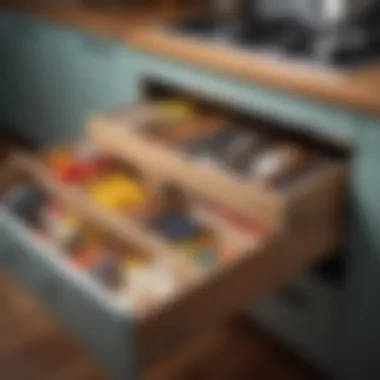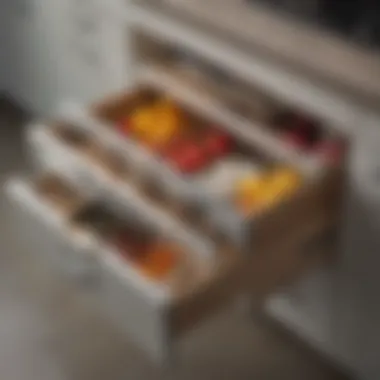Maximizing Kitchen Drawers: Organization & Innovation


Intro
Kitchen drawers serve as more than just simple storage spaces; they play a crucial role in the functionality of any culinary environment. In this guide, we will examine the multifaceted contributions of kitchen drawers to organization and efficiency. With thoughtful designs and clever organization techniques, one can transform a cluttered kitchen into a streamlined workspace.
Notably, drawers are essential for both everyday cooking tasks and special culinary endeavors. This article aims to provide insights that enhance the utility of kitchen drawers and help maximize their operational capacity. From essential items to innovative storage solutions, we shall explore how to unlock the full potential of kitchen drawers.
"A well-organized kitchen can greatly improve your cooking experience and overall efficiency."
In the following sections, we will cover various aspects, including organization techniques, the importance of functionality, and innovative design ideas. Understanding these elements is vital for anyone looking to optimize their culinary space.
Foreword to Kitchen Drawers
Kitchen drawers serve a pivotal role in optimizing storage and enhancing efficiency within culinary spaces. They are often overlooked but are fundamental in maintaining order and functionality in any kitchen. Understanding kitchen drawers entails recognizing their evolution, various types, and innovative designs. This foundational knowledge empowers users to maximize the utility of their kitchen, resulting in an organized and effective cooking environment.
The Evolution of Kitchen Drawer Design
The design of kitchen drawers has undergone remarkable transformations over time.
Initially, functionality was prioritized. Early kitchen drawers were simply boxes that provided basic storage with little regard for ease of use or aesthetics. As kitchens evolved into areas not only for cooking but also for social interaction, the design of drawers began to reflect this shift. Modern kitchen drawers now feature soft-close mechanisms, accommodating a broader range of utensils and tools while minimizing slamming noises, a common complaint in traditional setups.
Materials and construction techniques have also advanced. From solid wood to composites and laminated finishes, the choice of materials now bends towards durability, ease of maintenance, and visual appeal. The integration of sustainable practices in manufacturing has also gained importance, with many consumers seeking eco-friendly options in kitchen furnishings.
In recent years, multifunctional designs have gained prevalence. For example, drawers with integrated spice racks or built-in cutting boards reveal that functionality can go hand in hand with innovative design.
Understanding the Purpose of Kitchen Drawers
The primary purpose of kitchen drawers is to provide a convenient and organized space for storing essential kitchen items. They help categorize tools, utensils, and appliances, allowing for efficient access during cooking.
- Storage Solutions: They accommodate various kitchen items, from cutlery to gadgets, ensuring items are easy to find and reach.
- Space Optimization: Drawers make use of space more effectively than shelves, especially in smaller kitchens. They can fit into various layouts, offering flexibility.
- Ease of Use: Unlike cabinets, drawers can be fully pulled out, providing complete visibility of contents. This assists in quicker meal preparations, enhancing overall efficiency.
- Safety Considerations: Young children can be kept safe as drawers can be designed to close gently, reducing the risk of pinched fingers. Moreover, storing sharp tools out of immediate sight minimizes accidents.
"Efficient kitchen organization is not just about aesthetics; it streamlines daily routines and fosters a more enjoyable cooking experience."
By understanding the multifaceted functions and historical developments of kitchen drawers, users can make informed choices that not only benefit their cooking experience but also contribute positively to the overall kitchen design.
Types of Kitchen Drawers
Understanding the various types of kitchen drawers is crucial for optimizing storage functionality and organization. Each type serves a specific purpose, catering to different culinary needs and preferences. Whether you are a casual cook or a culinary enthusiast, knowing the characteristics and benefits of these drawers enhances your kitchen's efficiency.
Standard Kitchen Drawers
Standard kitchen drawers are commonly used in most kitchens. They usually measure around 24 inches in width and come in various heights. These drawers are efficient for storing utensils, small kitchen tools, and other frequently used items. The layout and size of standard drawers make them ideal for quick access to essential items during cooking.
Due to their versatility, standard kitchen drawers can be configured in numerous ways. Many homeowners opt to use drawer dividers to create compartments for spoons, forks, and knives, ensuring that everything remains organized. This not only saves time but also reduces frustration when searching for specific tools.
Deep Drawers for Pots and Pans
Deep drawers are designed specifically for larger kitchen items, such as pots and pans. Their depth allows for ample storage space, making it easy to store bulky cookware without compromising accessibility. Typically, deep drawers can accommodate items that are difficult to fit in standard drawers, providing a dedicated space for heavy kitchenware.
The advantages of using deep drawers are numerous. They help prevent clutter by keeping heavy pots and pans in a designated area. Furthermore, they enhance organization by allowing stacking or vertical storage of cooking vessels. In doing so, these drawers simplify the cooking process, as all necessary items are at hand.
Drawer Slides and Mechanisms


The efficiency of kitchen drawers is not only determined by their size but is also significantly influenced by their sliding systems. Drawer slides are the mechanisms that enable smooth opening and closing. They come in various styles, such as side slides, under-mount slides, and soft-close mechanisms.
Soft-close drawer slides, in particular, offer a refined touch to kitchen drawers. They prevent slamming by gently pulling the drawer closed. This feature enhances user experience, especially in busy kitchens. High-quality slides, made from durable materials, can support heavier loads and ensure longevity for frequent use.
"Understanding the specific uses of various drawer types unlocks the potential for a more organized and efficient kitchen."
By analyzing your storage needs and preferences, you can make informed decisions that enhance your culinary experience.
Organizing Kitchen Drawers Effectively
Organizing kitchen drawers is essential for both functionality and convenience in any culinary space. A well-organized drawer not only saves time during meal preparations but also reduces frustration when searching for specific tools or utensils. It allows cooks to locate what they need quickly, enhancing their overall cooking experience. Moreover, effective organization can help preserve the lifespan of kitchen tools by reducing wear from clutter or misuse.
In this section, we will delve into specific strategies that elevate the organization of kitchen drawers. Understanding how to categorize tools, implement dividers, and utilize vertical space provides several benefits that cater to individuals of different cooking styles.
Categorizing Kitchen Tools
Categorization plays a vital role in drawer organization. Grouping utensils, gadgets, and other tools based on their use can significantly improve accessibility. For example, separate sections for cutlery, cooking utensils, and measuring tools can streamline the search process. A logical grouping helps reinforce a routine, making it easier for users to identify where each item belongs.
Key points to consider when categorizing include:
- Use Frequency: Place frequently used items at the front or on top for easy access.
- Function: Group items by their function, such as baking, cooking, or serving.
- Size: Consider the size of tools. Larger items may need their own space, whereas smaller items can fit together.
Using Drawer Dividers and Organizers
Drawer dividers are a straightforward yet effective solution to maintain order. These inserts create sections within a single drawer, reducing chaos by compartmentalizing various tools. The right organizer also prevents the clattering and scratching of utensils against each other.
Dividers can be adjustable or fixed, depending on the flexibility needed. Installing organizers like mdesign Kitchen Drawer Organizer or Oxo Good Grips Expandable Utensil Holder can further enhance the experience.
A few thoughts when using dividers include:
- Material: Choose dividers crafted from materials that won’t scratch or damage utensils.
- Customization: Consider systems that can be adjusted as your needs change.
Maximizing Vertical Space
Maximizing vertical space within drawers can lead to more storage opportunities. Utilize the vertical area by installing tiered organizers or stacking trays. This approach can be particularly helpful in organizing smaller items such as spices, measuring spoons, or kitchen gadgets. By elevating these items, visibility increases, making it easier to grab what you need without disruption.
In practice, these tips may help:
- Tiered Organizers: Look for organizers that allow stacking of items.
- Hooks and Racks: Utilize hooks on the inside of drawer fronts for hanging smaller tools like measuring cups.
- Baskets: Consider narrow baskets that can fit within the height of the drawer for vertical storage without wasting space.
By incorporating these structured methods for organizing kitchen drawers, cooking spaces can achieve new levels of efficiency and convenience. A functional drawer layout not only enhances culinary tasks but also promotes a more enjoyable experience in the kitchen.
Innovative Solutions for Kitchen Drawers
The kitchen is not just a place for cooking; it is an epicenter of creativity and activity. As such, innovative solutions for kitchen drawers can significantly enhance functionality and efficiency. These solutions are tailored to meet the needs of modern cooking environments by providing enhanced organization, better space utilization, and contributions to a seamless culinary experience. Adopting these innovations is more than aesthetics; it improves cooking processes and saves time.
Pull-Out Shelves and Organizers
Pull-out shelves offer a practical approach to maximizing drawer space by increasing accessibility. They allow users to easily reach items situated in the back without having to dig through clutter. Putting frequently used items on these shelves ensures they are always at hand.
- Advantages:
- Considerations:


- Improved visibility of stored items.
- Easy access reduces the frustration of searching through deep drawers.
- It may require precise measurements to fit the drawer.
- Selecting robust materials ensures durability over time.
Exploring units like the Rev-A-Shelf or similar brands can lead to valuable enhancements in kitchen design.
Drawer Inserts for Utensils
Drawer inserts are essential for maintaining order in kitchen utensils. They provide designated spaces for knives, forks, spoons, and other tools, preventing chaos in drawers. This can significantly decrease time spent during meal preparation.
- Benefits:
- Easier to locate specific utensils quickly.
- Protects utensils from damage by keeping them separated.
When choosing inserts, consider materials that are easy to clean and resistant to moisture, like bamboo or plastic.
Utilizing Smart Technology
Smart technology in kitchen drawers integrates digital solutions for improved functionality. This includes features like built-in lighting that turns on when the drawer opens and digitized inventory systems that notify users when stocks are low.
- Benefits:
- Enhances organization through automation.
- Increases overall kitchen efficiency by providing timely reminders for needed items.
Adopting systems such as those offered by IKEA's smart home solutions can revolutionize how kitchen drawers are managed.
"Innovative solutions not only make kitchens more organized but also transform cooking into a more enjoyable task."
These innovative solutions for kitchen drawers underline the necessity of integrating functionality with design. They pave the way for an optimized cooking environment where efficiency meets creativity.
Maintaining Kitchen Drawers
Maintaining kitchen drawers is a vital aspect of ensuring functionality and longevity in any culinary space. Regular upkeep helps prevent the accumulation of dirt and debris, which can hinder efficiency during cooking. It also enhances the overall aesthetic of the kitchen, making it a more inviting area. Beyond cleanliness, a properly maintained drawer system can save time and promote better organization, aspects of kitchen management that are often overlooked.
Cleaning and Care Tips
To maintain kitchen drawers effectively, a systematic cleaning routine is essential. Here are some practical cleaning and care tips:
- Empty the Drawers: Begin by removing all items from the drawer. This provides a clear view and access to all corners.
- Dust and Wipe: Use a soft cloth or microfiber duster to remove any dust. Follow this by wiping the surfaces with a damp cloth to eliminate sticky residues or food spills.
- Clean the Tracks: Drawer slides or tracks often collect grime. A small brush or vacuum attachment can clear debris that may obstruct opening or closing the drawer smoothly.
- Use Safe Cleaning Products: When using cleaning solutions, ensure they are safe for the drawer material—be it wood, metal, or plastic. Avoid harsh chemicals that can damage finishes or surfaces.
- Inspect for Damage: As you clean, look for any signs of damage or wear. Early detection can prevent larger issues down the line.
"Regular maintenance not only extends the life of kitchen drawers but also enhances daily use efficiency."
Addressing Common Drawer Issues
Kitchen drawers can present various issues over time. Understanding these problems allows for timely resolutions and keeps your kitchen running smoothly. Common drawer issues include:
- Sticking Drawers: Often a result of debris accumulation or misaligned slides. Cleaning the tracks can usually resolve this issue.
- Loose Handles: Over time, drawer handles can become loose. Regularly check and tighten screws to prevent them from falling off.
- Sagging Drawers: Heavy items can cause drawers to sag. If this happens, re-evaluate how items are stored and consider reinforcing the drawer with brackets or stronger materials.
- Odors: If any drawer emits an unpleasant smell, empty it and clean thoroughly. Placing baking soda in the drawer for a few hours can also assist in eliminating odors.
By proactively maintaining kitchen drawers through regular cleaning and addressing common issues promptly, one can enhance the functionality and longevity of these essential kitchen elements.
The Role of Kitchen Drawers in Culinary Efficiency


Kitchen drawers play a crucial role in enhancing culinary efficiency. Their design and organization directly impact how quickly and effectively a cook can access tools, utensils, and ingredients. A well-planned drawer system minimizes time wasted searching for items, allowing for a smoother cooking experience. This clarity of purpose makes functionality in kitchen drawers a vital element in any culinary setting.
Streamlining Cooking Processes
An essential aspect of streamlining cooking processes is ensuring that everything needed for meal preparation is readily accessible. By organizing kitchen drawers methodically, one can significantly reduce the time spent searching for specific tools or items. Here are key elements to consider:
- Zoning: Group similar items together. For example, keep all baking utensils in one drawer and cooking tools in another. This approach decreases the chances of having to dig around in a cluttered space.
- Visibility: Use clear drawer inserts or labeled containers. This makes it easy to see at a glance what is available. It promotes quick decision-making, which is essential when cooking complex meals.
- Accessibility: Prioritize frequently-used items. Tools like knives, spatulas, and measuring spoons should be within easy reach. This consideration ensures that the cook can maintain a steady workflow without interruptions.
Creating an Intuitive Workflow
A seamless workflow in the kitchen elevates cooking to an enjoyable activity rather than a chore. To achieve this, kitchen drawers should be tailored to support the sequence of culinary tasks. Elements that contribute to an intuitive workflow include:
- Streamlined Layout: Consider the layout of the kitchen. Drawers should be positioned based on their usage during cooking. This means that items needed first in the preparation process should be closest at hand, while specialty items can be stored further away.
- Modular Systems: Embrace modular organizers that can be adjusted based on changing needs. This flexibility helps address various culinary projects, whether preparing a simple weeknight dinner or hosting a festive gathering.
- Thoughtful Design: Integrating drawers that can accommodate various heights and sizes of utensils can also influence workflow positively. A well-planned display reduces cognitive load, letting cooks focus on their culinary creations.
Effective drawer organization not only saves time, but also enhances the overall cooking experience, ensuring that every meal preparation is executed with precision and ease.
In summary, the role of kitchen drawers contributes significantly to culinary efficiency. Streamlining cooking processes and creating an intuitive workflow are crucial components in optimizing kitchen spaces. Cook enthusiasts of all levels can benefit from these principles, leading to enhanced enjoyment in their culinary endeavors.
Customizing Kitchen Drawers for Unique Needs
Customizing kitchen drawers is essential for enhancing the usability and efficiency of any culinary space. Every kitchen is unique, reflecting the personal style and specific requirements of the individual or family that uses it. Tailoring the drawer configurations and incorporating specialty gadgets not only increases convenience but also maximizes storage space and functionality.
Understanding how to best adapt kitchen drawers to meet your distinct needs can change your cooking experience fundamentally. Attention to detail in customization can lead to a more organized kitchen, making it easier to retrieve essential tools and ingredients promptly. In this guide, we will explore effective ways to tailor drawer layouts and wisely integrate specialty items which can significantly contribute to an efficient kitchen setup.
Tailoring Drawer Configurations
Tailoring drawer configurations involves assessing and adjusting the internal organization to suit personal cooking habits. Different people use their kitchens in various ways, thus necessitating different layouts.
- Assess Your Needs: Begin by identifying which tools and items are used most frequently. For instance, a chef may prefer deeper drawers for larger pots, while a casual home cook may focus on utensil-sized compartments.
- Customize for Accessibility: It is vital to position frequently used utensils and gadgets near the top or in more accessible drawers. Avoid placing heavy items in high drawers.
- Consider Size and Depth: Evaluate the size of your kitchen drawers. Some may benefit from shallow drawers for smaller items like spoons and ladles, while others might need wider configurations for larger items like mixing bowls.
- Use Dividers: Drawer dividers help segregate items, but they should be tailored to the specific sizes of the kitchen instruments you frequently use. This can reduce clutter and facilitate quicker access during cooking.
In sum, tailoring drawer configurations enhances user-friendliness, allowing for a smoother cooking process and promoting an organized space.
Integrating Specialty Gadgets
Incorporating specialty gadgets into kitchen drawers is another vital strategy for customization. Specialty tools can streamline cooking tasks and elevate the culinary experience.
- Identify Specialty Tools: Acknowledge what specific kitchen tools can enhance your cooking practices. Items like garlic presses, herb scissors, or spiralizers can be very useful.
- Smart Storage Solutions: Use specialized drawer inserts designed for these gadgets. For example, a knife block insert can safely store knives without risking damage or injury.
- Consider Multi-functional Gadgets: Select gadgets that serve multiple purposes. For instance, a can opener that also functions as a bottle opener helps save space in drawers.
- Placement: Position these specialty items near the drawer’s front for easy reach, especially when preparing ingredients or cooking. Keeping these organized ensures they do not get lost among more common kitchen tools.
The End: The Future of Kitchen Drawers
Kitchen drawers have evolved significantly over the years. Their role has expanded beyond simple storage, becoming essential components in modern culinary environments. As we consider the future, understanding trends and innovations in kitchen drawer design is crucial. This conclusion encapsulates the emerging patterns that will shape how kitchen drawers function and enhance the cooking experience.
Emerging Trends in Kitchen Storage
In recent years, homeowners have increasingly prioritized efficient storage. Designs are adapting to fit smaller spaces without sacrificing function. For instance, pull-out drawers and corner solutions are becoming commonplace in compact kitchens. Alongside this, there is a growing preference for modular designs that allow for customization according to personal tastes and requirements. Features such as soft-close technology and tailored compartments cater to a meticulous approach to organization.
- Smart Technology Integration: There is a noticeable shift towards incorporating technology in kitchen drawers. Smart systems can assist users in locating items swiftly, track inventory, and even manage expiration dates for perishable products.
- Multi-Functional Spaces: Drawers equipped with built-in knife blocks, cutting boards, or charging stations for gadgets showcase the trend toward multifunctionality. This allows kitchens to adapt to diverse cooking styles and practices.
Sustainability and Design Innovation
Sustainability continues to be a paramount consideration as consumers become more aware of their environmental impact. Eco-friendly materials, such as bamboo and recycled composites, are being used more frequently in drawer design. This not only meets consumer demand but also aligns with broader efforts toward reducing waste in kitchen production processes.
- Durability and Maintenance: Innovative designs are focusing on longevity, reducing the need for replacements. Durable finishes are also being utilized to minimize wear over time. Fewer replacements mean less waste, contributing to an overall more sustainable model.
- Aesthetic Appeal: The future of kitchen drawers also embraces a balance between functionality and elegance. Minimalist designs with clean, simple lines reflect modern tastes. Furthermore, colors and textures are expanding beyond traditional wood finishes, allowing for more personalized kitchen aesthetics.
"The best kitchen storage solutions are those that blend practicality with style, reflecting the owner's personality while meeting their needs."
In summary, the future of kitchen drawers is a promising amalgamation of efficiency, sustainability, and technological integration. As these elements evolve, they will redefine how kitchens are organized and how culinary tasks are approached. These drawers will not only serve as spaces for storage but will also enhance the overall cooking experience, leading to more enjoyable and efficient culinary adventures.















